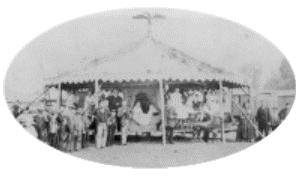The Dentzel Family Carousel Story

For more than a century, the Dentzel name has been identified with excellence in the pioneering and development of the hand carved carousel. Its wooden figures, whirling action, color, lights and band organ music combined to make America's favorite amusement ride a joyful experience for the entire family.
Carousels can be traced back to the Middle East, and earlier to India and Pre-Columbian America. Although their origin is not exactly known, they have been around for thousands of years. Used as a ride for amusement as well as cavalry training, the spinning configuration traveled to Europe via the crusaders of the 10th and 11th centuries. In Europe the carousel was first used by the knights and soldiers as a training devise, usually kept very secret so the rivals would not know about this extra practice occurring. Eventually the royalty brought them into special private pleasure gardens. By the 18th century its use was widespread as craftsmen were making them for the general public as an amusement ride. The first carousels were either human or pony powered, spun by pushing or pulling the sweeps around like horizontal wheel spokes. On these early carousels the seats, baskets, or animals were "flying". Eventually hanging platforms were attached too for the animals to stand on. After the early 1900's overhead shafts and cranks to "gallop" the animals became more common. Riding the wave of the industrial revolution, steam, gasoline and electricity powered the carousels. Today, with modern mechanical techniques, a Dentzel 15 rider carousel can easily be powered by an 8 year old at the recumbent pedaling seat, or a handcrank or by solar produced electricity. Our basic 21st century carousel is a "Flying Horses" style commonly found up through the late 19th century. The oldest operating carousel in the United States today is located at Watch Hill, Rhode Island, a Dare "Flying Horses" machine built in 1883.
Site Copyright © 1997-2021 by Dentzel Carousel Company